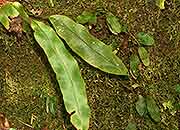Elaphoglossum hybridum (Bory) Brack.
Synonyms |
Acrostichum hybridum Bory |
|---|---|
Common name |
|
Description |
Rhizome shortly creeping, often appearing to be erect, diameter to 7 mm; rhizome scales blackish brown, linear-lanceolate in outline, tapering to a point, margins entire, up to 5 mm long; phyllopodia absent. Fronds tufted, firmly herbaceous, simple, brittle, deep green, arching, strongly dimorphous. Sterile frond: stipe up to 20 cm long, straw-coloured to pale brown, with many black, squarrose deciduous scales, to 5 mm, also with sparse minute erect glandular hairs at base of the stipe; lamina (5.5-)14-22 × 2.2-5.5 cm, narrowly oblong to narrowly elliptic in outline, apex pointed, base wedge-shaped to rounded, margin and midrib set with small, deciduous, linear, black scales, 1-2 mm long on the lower surface, upper surface glabrous; veins evident, free, simple or once forked, 1-2 mm apart, at 70-80° angle to the costa; hydathodes absent. Fertile frond: usually ± half the lenght of the sterile; stipe scales as sterile frond; lamina narrower than sterile lamina, 3.1-15 x 1.4-3 cm, narrowly oblong to narrowly ovate in outline, apex and base similar to sterile lamina, costa with few scales, marginal scales absent; veins parallel and visible; sporangia covering the whole undersurface of the lamina; intersporangial scales absent. |
Notes | Can be confused with E. chevalieri, this fern however has rusty brown (not blackish) scales occuring over the whole lamina, above and below, and a densely hairy stipe. |
Derivation | hybridum: of hybrid origin, reference unclear. |
Habitat | Growing on moist earth banks next to water or on wet rock faces in deeply shaded ravines in evergreen forest, also bamboo zone and moorland. |
Distribution worldwide | Possibly of circumpolar origin, occuring on the subantartic islands Gough & Tristan da Cunha, also Africa, Comoro Isl., Réunion, Mauritius. |
Distribution in Africa |
Cameroon, Congo, Dem. Republic of Congo, Equatorial Guinea (incl. Bioko), Ethiopia, Kenya, Malawi, Mozambique, Rwanda, South Africa, Tanzania , Uganda, Zimbabwe. |
Growth form |
Lithophytic, terrestrial. |
Literature |
|


